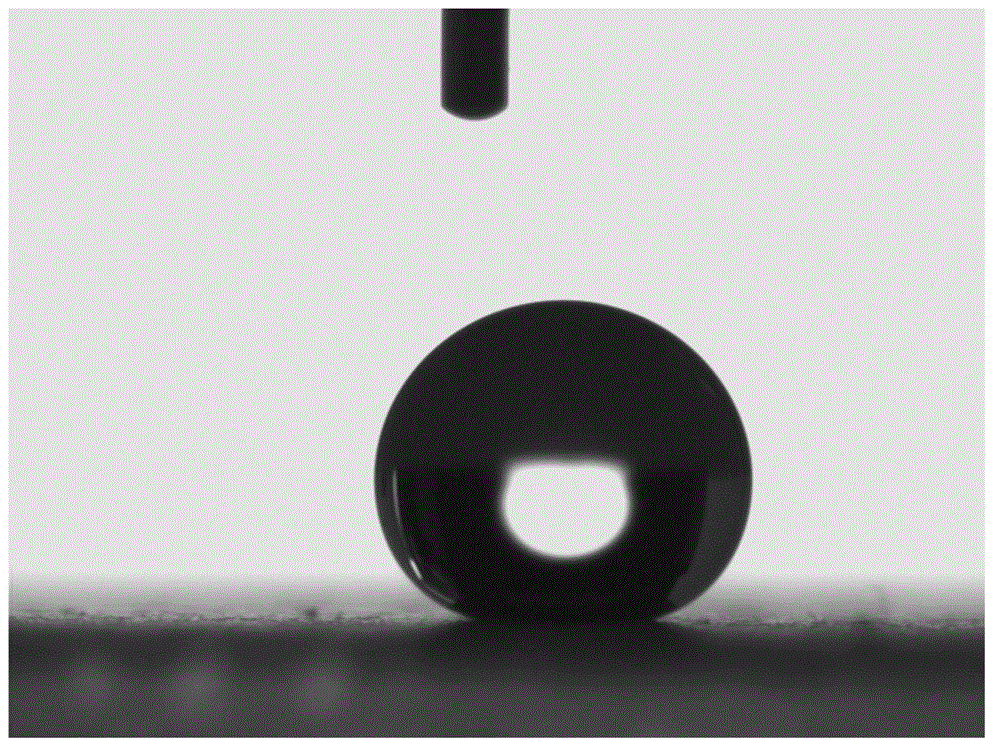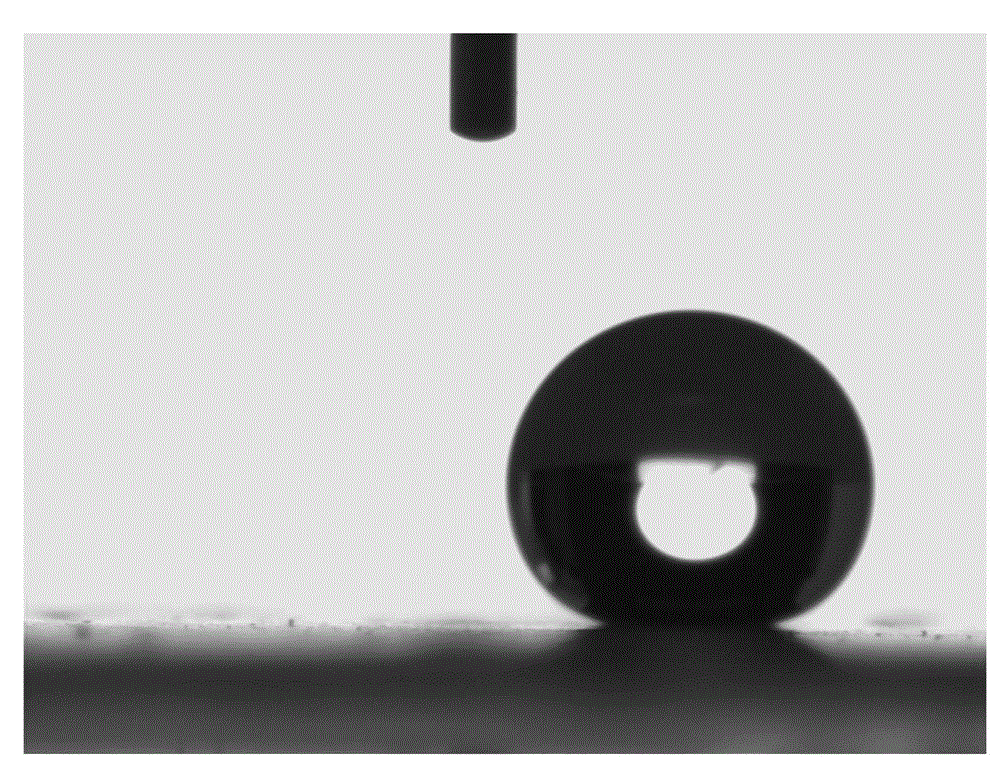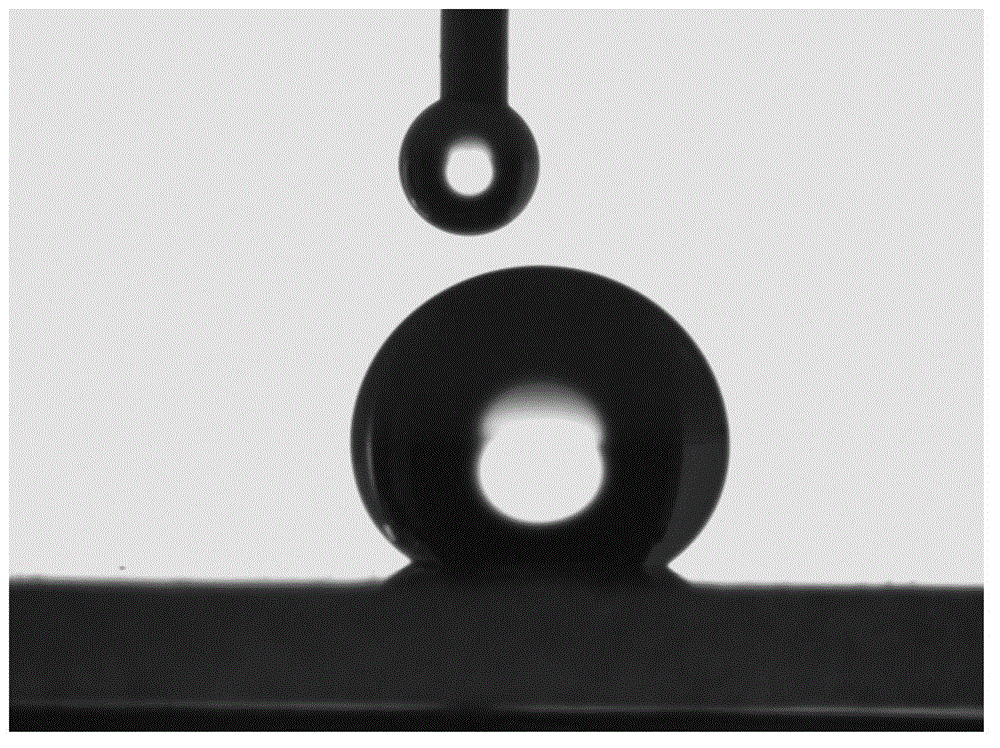Superhydrophobic polypropylene film and preparation method thereof
A polypropylene film and super-hydrophobic technology, applied in the field of super-hydrophobic polypropylene film and its preparation, super-hydrophobic polypropylene film, can solve the problems of expensive materials, difficult to popularize and apply, etc., achieve stable super-hydrophobic properties, wide application prospects, good reproducibility
- Summary
- Abstract
- Description
- Claims
- Application Information
AI Technical Summary
Problems solved by technology
Method used
Image
Examples
Embodiment 1
[0021] The superhydrophobic polypropylene film is made by the following preparation method:
[0022] Step 1: Rinse the dust on the surface of fresh taro leaves with tap water, and then cut the taro leaves to a size of 20 cm and a width of 15 cm;
[0023] The second step: put the taro leaves cut out in the first step into a pouring mold with a height of 8 cm as the original template for use;
[0024] Step 3: Mix liquid room temperature vulcanized silicone rubber with its catalyst (dibutyltin dilaurate) and crosslinking agent (tetraethyl orthosilicate) in a ratio of 100:1:5 and stir for 20 minutes, then set aside Take out the air bubbles in the mixture in a vacuum box, and then pour the mixture of room temperature vulcanized silicone rubber on the fresh taro leaves in the mold. After curing for 24 hours at room temperature and atmospheric environment, gently tear off the cured room temperature vulcanized rubber from the taro leaves. Silicone rubber, obtain vulcanized silicone r...
Embodiment 2
[0028] In this embodiment, the superhydrophobic polypropylene film is made by the following preparation method:
[0029] Step 1: Rinse the dust on the surface of the fresh taro leaves with tap water, and then cut the taro leaves into a size of 50 cm and a width of 50 cm;
[0030] The second step: put the taro leaves cut out in the first step into a pouring mold with a height of 8 cm as the original template for use;
[0031] Step 3: Mix liquid room temperature vulcanized silicone rubber with its catalyst (dibutyltin dilaurate) and crosslinking agent (tetraethyl orthosilicate) in a ratio of 100:5:20 and stir for 30 minutes, then set aside The air bubbles in the mixture are extracted in a vacuum box, and then the mixture of room temperature vulcanized silicone rubber is poured on the fresh taro leaves in the mold, and the cured silicon vulcanizate is gently torn off from the taro leaves after curing for 30 hours at room temperature and atmospheric environment Rubber, obtain vul...
Embodiment 3
[0035] In this embodiment, the superhydrophobic polypropylene film is made by the following preparation method:
[0036] Step 1: Rinse the dust on the surface of fresh taro leaves with tap water, and then cut the taro leaves to a size of 30 cm and a width of 30 cm;
[0037] The second step: put the taro leaves cut out in the first step into a pouring mold with a height of 8 cm as the original template for use;
[0038] Step 3: Mix liquid room temperature vulcanized silicone rubber with its catalyst (dibutyltin dilaurate) and crosslinking agent (tetraethyl orthosilicate) in a ratio of 100:1:10 and stir for 10 minutes, then set aside Take out the air bubbles in the mixture in a vacuum box, and then pour the room temperature vulcanized silicone rubber mixture on the fresh taro leaves in the mold. After curing for 20 hours at room temperature and atmospheric environment, gently tear off the cured silicon vulcanizate from the taro leaves Rubber, obtain vulcanized silicone rubber s...
PUM
 Login to View More
Login to View More Abstract
Description
Claims
Application Information
 Login to View More
Login to View More - Generate Ideas
- Intellectual Property
- Life Sciences
- Materials
- Tech Scout
- Unparalleled Data Quality
- Higher Quality Content
- 60% Fewer Hallucinations
Browse by: Latest US Patents, China's latest patents, Technical Efficacy Thesaurus, Application Domain, Technology Topic, Popular Technical Reports.
© 2025 PatSnap. All rights reserved.Legal|Privacy policy|Modern Slavery Act Transparency Statement|Sitemap|About US| Contact US: help@patsnap.com



